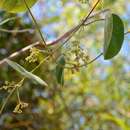en
names in breadcrumbs


The plant is very common in hedges at the foothills and up to c. 2300 m. It is a source of alkaloids like Seeprine, Bebeerine and Cissampeline. The leaves and roots are used as a cure for dyspepsia, diarrhoea, dropsy and in snake-bite. The stem yields a strong fibre.
Cissampelos pareira (velvetleaf)[1] is a species of flowering plant in the family Menispermaceae.
It is a slender tomentose climber. The leaves are peltate, 2.5–12 cm long, 2.5–11.5 cm broad, triangularly broad-ovate, or orbicular, obtuse, mucronate, base cordate or truncate, ± tomentose on both sides; petiole pubescent. Flowers are small in size, pedicels filiform. Male flowers clustered in the axil of a small leaf; sepals are 4 in number, obovate-oblong, hairy outside; petals 4 in number, united to form a 4-toothed cup, hairy outside; stamens 4, column short, anthers connate, encircling the top of the column. Female flowers clustered in the axils of orbicular, hoary imbricate bracts, on 5–10 cm long racemes; sepal 1, petal 1; carpel 1, densely hairy; style shortly 3-fid. Drupe 4–6 mm long, 3–4 mm broad, subglobose, compressed, hairy-pubescent, red when fresh, black when dry, endocarp transversely ribbed, tuberculate. Seeds are horseshoe-shaped.[2]
Cissampelos pareira is used in Chinese herbology, where it is called xí shēng téng (Chinese: 锡生藤) or yà hū nú (Chinese: 亞乎奴). The species is also known as abuta and called laghu patha in Ayurvedic medicine. In Tamil Nadu it is called ponmusutai and it is used for a number of medicinal purposes.
Some attention has been paid to it in Kenya, Tanzania, and other places for its purported antimalarial properties in particular,[3][4] as well as in India for its antiviral properties, especially against Dengue virus.[5]
 Fruits of Cissampelos pareira during the month of October
Fruits of Cissampelos pareira during the month of October Cissampelos pareira (velvetleaf) is a species of flowering plant in the family Menispermaceae.